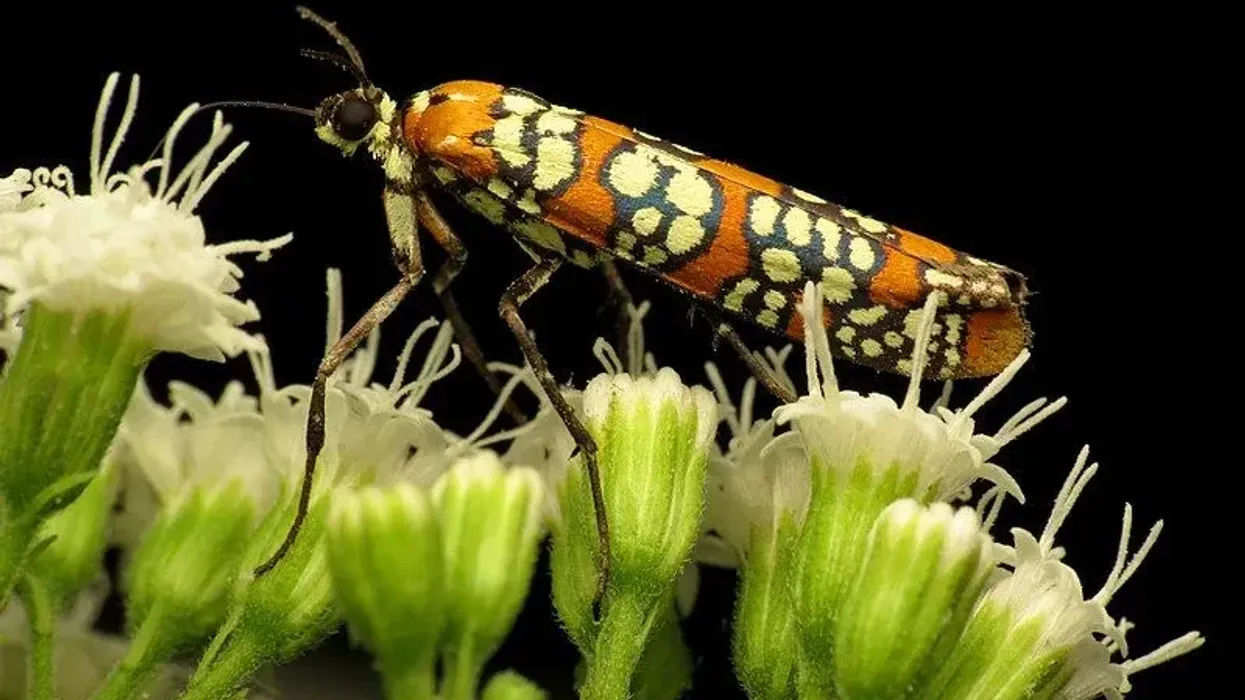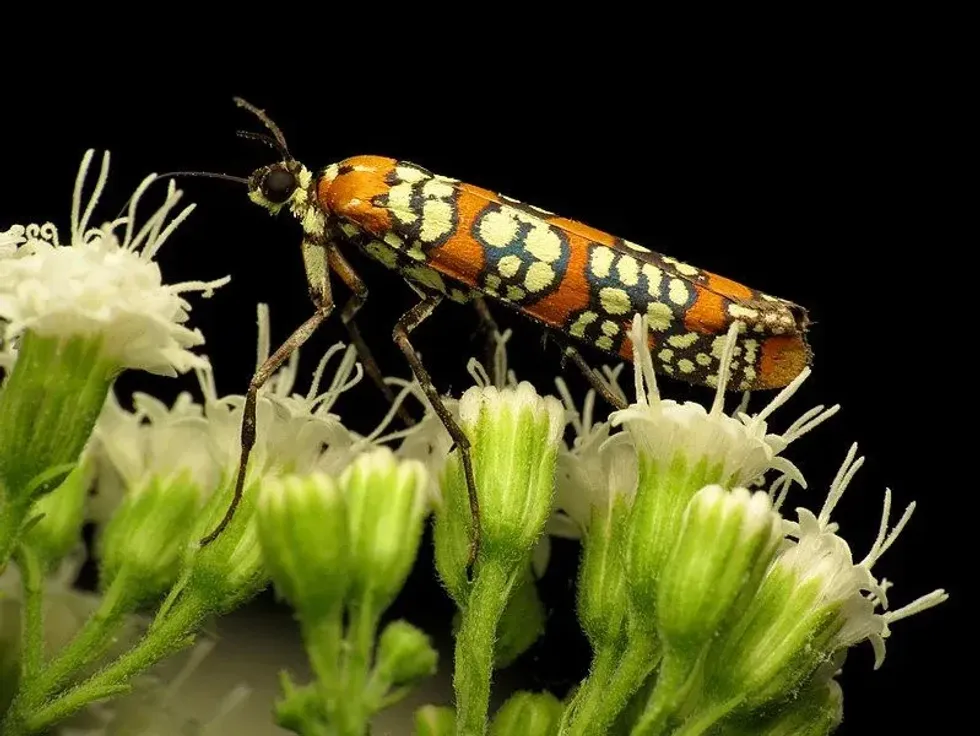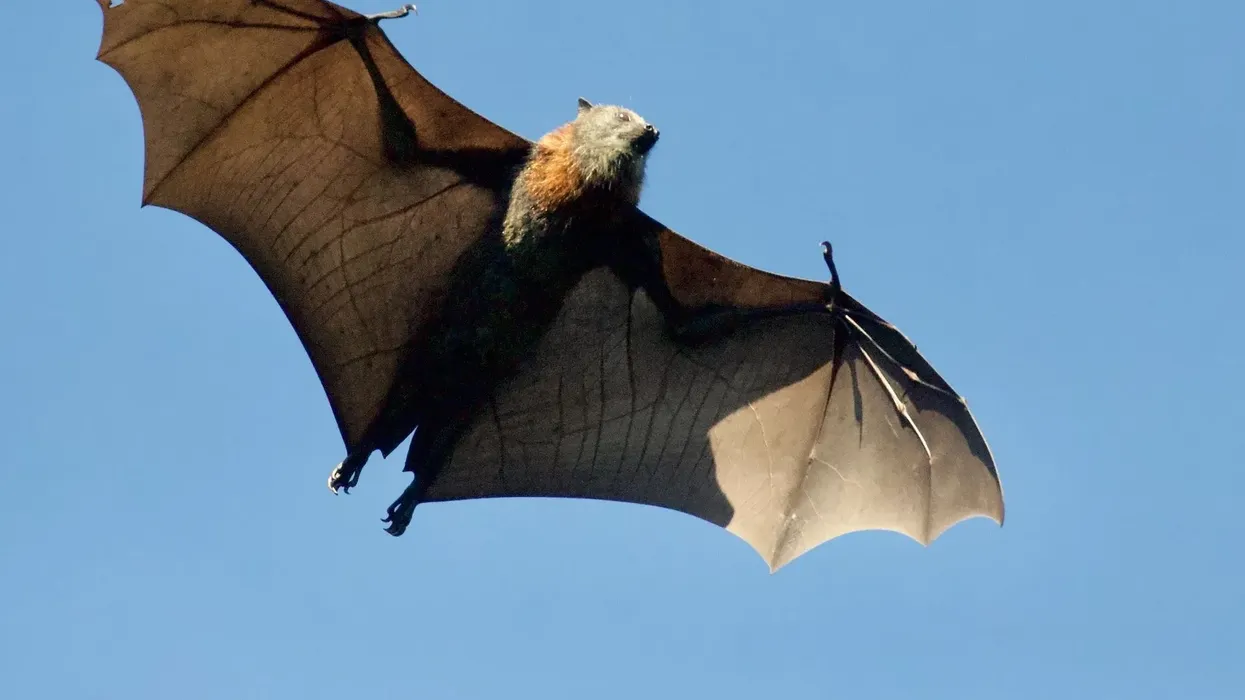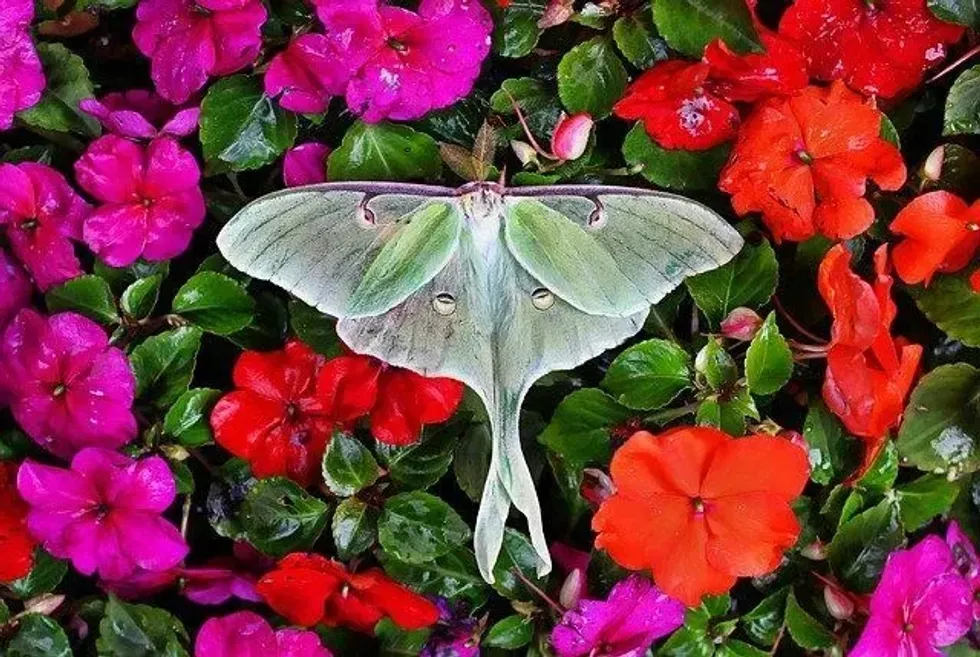When you hear moth, a dark-colored insect comes to your mind, right? But, would you ever imagine that a moth could be as beautiful as a butterfly?
Meet the ailanthus webworm moth, which looks like a jewel, with bright orange bands with clusters of white spots enclosed in black rings! How beautiful nature's creation is, which looks like a beetle when stationary and resembles a wasp while flying!
Its name, ailanthus webworm moth, may sound intriguing. Belonging to the ermine family of webworms, it infests host plants, paradise trees, and the tree of heaven. Originating in South Florida, it is spread across the United States.
It is known for its unique coloration and body. Though many other moths are nocturnal, the webworm moth (Atteva aurea) is diurnal. This insect feeds on the nectar of the flowers during the daytime and makes an excellent pollinator.
The tree of heaven was thriving in colder climates than Florida. Hence, this moth hopped on board with them and moved toward North America. It has cousins like gypsy moth and luna moth, which you can explore.
Ailanthus Webworm Moth Interesting Facts
What type of animal is an ailanthus webworm moth?
The Ailanthus webworm moth is an insect that is a beautiful bright orange. Interestingly, this color serves as a warning to predators that this insect could be toxic or distasteful if eaten.
What class of animal does an ailanthus webworm moth belong to?
The Ailanthus webworm moth belongs to the class Insecta of Arthropoda phylum. This insect stands apart as it curves its wings length-wise, along its body. Other similar species of moths do curve along the length of their body, but this is the only species to have such a color pattern too.
How many Ailanthus Webworm Moths are there in the world?
The population size of the Ailanthus webworm moth is unknown, but we know that there are 1,60,000 species of moths in the world. Of these, 11,000 species are present in the United States itself.
Where does an ailanthus webworm moth live?
Ailanthus webworm is a tropical moth native to South and Central America, occasionally seen in Eastern Canada. This moth cannot survive in cold weather.
They live on paradise trees and trees of heaven. These trees are also its larval host plants.
What is an ailanthus webworm moth's habitat?
The Atteva aurea habitat consists of tropical regions, which are their homelands. They range from South Florida to Costa Rica. The northern population gets wiped out during cold winters. Then, starting in spring, it spreads in North America, moving to the warm southern regions.
Who do ailanthus webworm moths live with?
These moths, which are tropical ermine webworms, live communally. They are typically called webworms, as they live inside the loose webs enclosed by the leaves of host plant trees and shrubs.
Specifically, the ailanthus webworm moth can have a single community web, which can simultaneously house all four stages of its life cycle: eggs, larvae (caterpillars), pupae, and adults. This community web can sustain throughout summer.
How long does an ailanthus webworm moth live?
The female ailanthus webworm moth dies after laying eggs during the mating season. It is interesting to know that only one generation of these ermine moths lives every year. The single moth takes about four weeks from the egg stage to the egg-laying adult stage. Some studies have shown that male moths have a long life span.
How do they reproduce?
Mating happens in the morning, and the female ailanthus webworm moth lays an abundance of eggs in the evening. These eggs are not in clusters but stay individually in the larval silk webs created on the bunch of leaflets.
The eggs can live on other larvae within the same web, which houses several generations of eggs in different stages, converting into a large communal web.
Many larvae (caterpillars) feed on the leaves, flowers, and seeds, staying within the web safely and eventually pupating into the chrysalis and then adults in the same location. Adults start to emerge from late spring until fall.
What is their conservation status?
The conservation status of the Ailanthus webworm moth Atteva is not listed as they are present in abundant numbers. They are not extinct as it is an abundant species and keeps emerging as new colonies every summer.
Ailanthus Webworm Moth Fun Facts
What do ailanthus webworm moths look like?

The Ailanthus webworm moth (Atteva aurea), aurea means golden, is a tropical ermine moth belonging to the family Attevidae. It is thin, and long, and curves its wings along the length of the body.
Its front wings are bright orange with white spots encircled with black rings, making it appear like a floral pattern. Its rear wings are grey with black parabolic shape outlines. The mouthparts are curved upward.
Its antennae are filamentous and are turned towards the head rather than backward. It appears like a beetle when stationary but resembles a wasp while flying.
How cute are they?
Aurea ailanthus webworm looks cute due to its bright coloration, and we are easily attracted to it. But, surprisingly, it keeps its predators at bay precisely because of these colors, indicating that it could be toxic.
How do they communicate?
In a way, their coloration is itself a communication to predators about their toxicity. But there are certain species of eared moths, which have evolved organs that produce sounds to keep their predators away.
They also frequently have a low-range, low-intensity, ultrasound whisper made by males for courtship indicating a sexual sound communication. In addition, some moths release pheromones to attract females.
How big is an ailanthus webworm moth?
Ailanthus ermine moths are about 1.5 in (3.8 cm) in wingspan length and can be somewhat similar to a butterfly when their wings are spread in flight.
How fast can ailanthus webworm moths fly?
The Ailanthus is not known for its fast-flying skills, though they fly during day time to extract nectar from flowers. But did you know that its cousin, a hawk moth is famous for its flight speeds which can go up to 12 mph (19 kph)?
How much does an ailanthus webworm moth weigh?
The ailanthus webworm moth is a lightweight insect comparable to a butterfly. They could weigh as much as a couple of rose petals! But, of course, many moth species weigh much more. The heaviest known moth is the giant wood moth, which can weigh up to an ounce and has a wingspan of up to 10 in (25.4 cm).
What are the male and female names of the species?
The male species is called the male ailanthus webworm moth, and the female is called the female ailanthus webworm moth.
What would you call a baby ailanthus webworm moth?
The life cycle of the ailanthus webworm moth consists of four stages: egg, larva (caterpillar), pupa (chrysalis), and adult. The baby moth is called a caterpillar, after which it pupates to become a winged moth.
What do they eat?
The Atteva aurea feeds on leaves, flowers, seeds, and nectar. They are invasive insects, meaning they slowly eat up the leaves of the residing plant, which becomes a food plant!
Are they dangerous?
The Attreva aurea is not dangerous but can be a minor pest in the backyard. They are good pollinators as they land on different flowers to extract the nectar, aiding pollination. But the ailanthus webworm moth is poisonous if eaten.
Would they make a good pet?
Moths do not make suitable pets as they are wild insects.
What is the ailanthus webworm moth's host plant?
The host plant of the Ailanthus webworm moth caterpillar is the Paradise tree (Simarouba glauca). However, the moth may also easily adapt to another plant, the tree of heaven (Ailanthus altissima), from which it derived its name too.
Do ailanthus webworm moths have a spiritual meaning?
Moths indicate that we may be hiding from ourselves and need to face the world to believe that we will eventually see the light.
Here at Kidadl, we have carefully created lots of interesting family-friendly animal facts for everyone to discover! Learn more about some other arthropods from our Banded Tussock Moth facts, and Plume moth facts.
You can even occupy yourself at home by drawing one on our Ailanthus webworm moth coloring pages.










